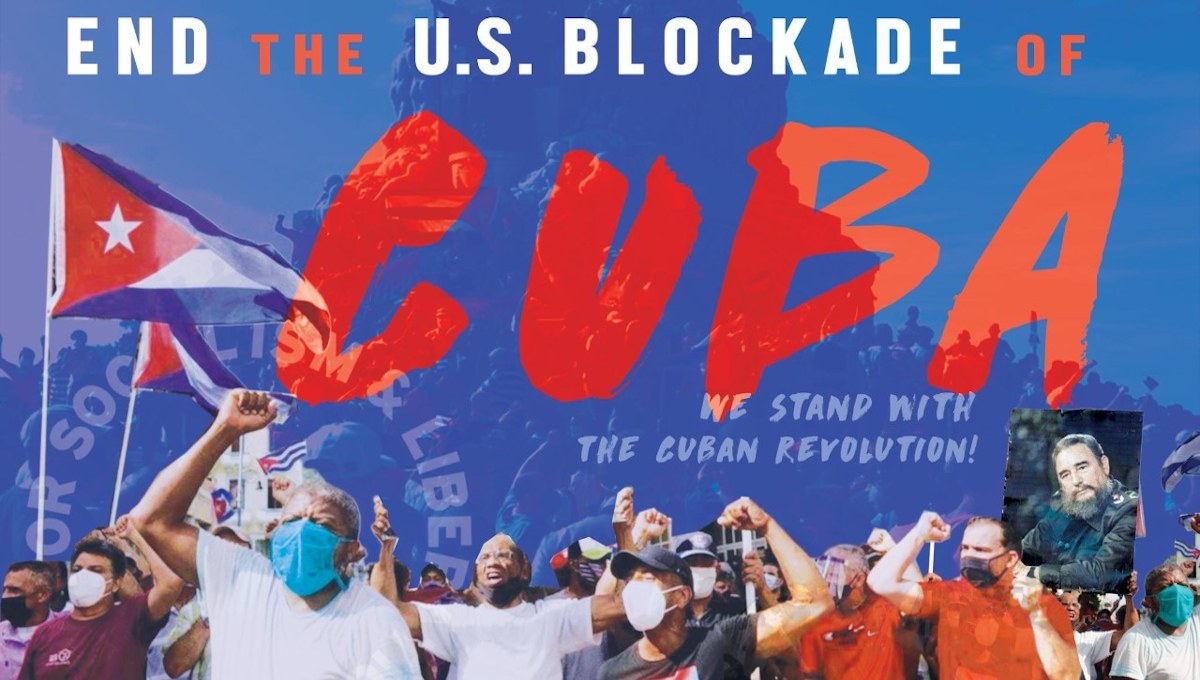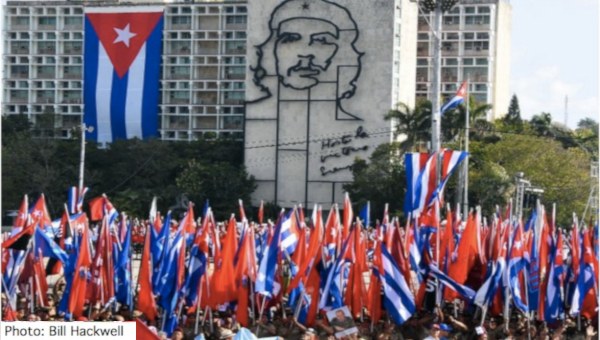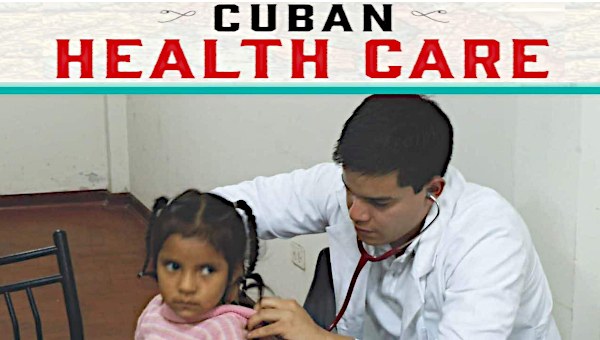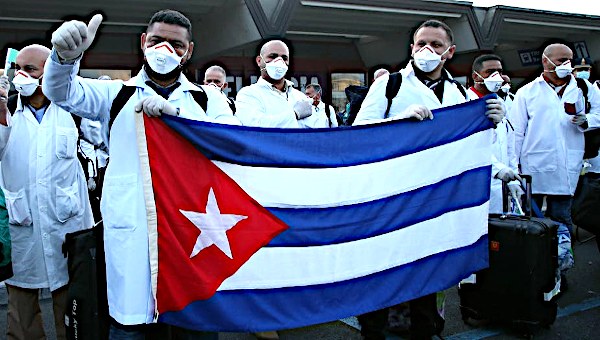Cuba: History Repeats
In 1989, the Soviet Union and its eastern bloc fell apart, literally overnight. The impact in Cuba was immediate and dramatic. Within six months, Cuba lost more than 70% of its international trade. Over the next five years, the island’s economy shrank by half. (In comparison, at the height of the Great Depression from 1929 to 1933, the US economy shrank by 30%.) The “special period in times of peace” took a toll across the island. Food and fuel shortages, electrical blackouts, lack of medicines – every aspect of Cuban life was affected.
One might expect that a humanitarian crisis of these proportions would engender sympathy among neighbors. But instead of sending food and medicine, Republican President George HW Bush and Democratic President Bill Clinton cynically pounced on an “opportunity” to undermine a stable socialist government. They worked across party lines to strengthen the US embargo, more accurately called a blockade, and to isolate a struggling island from international economic ties. The Cuban people rallied in the face of this historically unparalleled pressure, and the Cuban revolution survived.
Fast forward three decades, and the world finds itself in a pandemic. Two hundred million people sickened and four million dead. Economic devastation across the globe. And again, Democrats and Republicans see “opportunity” in Cuba – “Let’s beat them while they’re down!” President Trump initiated 243 measures strengthening the embargo of Cuba and further isolating our neighbor. (Click here for a comprehensive description of the embargo’s impact.) President Biden followed Trump’s example. Cuba is left with a crippled economy, food and fuel shortages, and, perhaps most significant in the midst of a worldwide health crisis, shortages of medicines.

Miami Interference
Allied with Miami’s Cuban-American mafia and its proliferating NGGOs (non-governmental ‘governmental’ organizations), social media is playing a new role largely unknown in the early 1990s. One particularly public group stands out. Cuba Decide (spelled the same in English and Spanish) is front and center. Their easily recognizable blue and white graphics were present at several demonstrations across the island on July 11.
But before we buy into the rhetoric of mass anti-government mobilizations that dominate the mainstream media, let’s take a closer look at the reality on the ground. Shortages of food and medicine mean long lines at stores, with many customers frustrated by the lack of supplies. Fuel shortages result in intermittent blackouts and undependable public transportation. For Cubans accustomed to subsidized food, inexpensive public transport, and world-class medical care, shortages caused largely by the internationalized US embargo take a grave toll.
The embargo restricts trade with nearly every country in the world, yet some western media outlets and the US political class blame an inefficient Cuban government bureaucracy for poor economic performance. The impact of the embargo was estimated at $5-billion last year, a substantial loss for a small island nation with a total gross national product of about $90-billion. Whatever “inefficiencies” might exist, the embargo far outweighs their impact. This is the same government that oversaw some of the best economic performance in Latin America during the 2000-2010 decade when GNP doubled – and this in spite of the embargo.
US Government Interference
Today, Biden’s Cuba “opportunity” is defined by a tightened embargo and a worldwide COVID pandemic that decreased tourist earnings by at least 75% in 2020. “Beat them when they’re down” takes on a whole new meaning. Cuba joins a long list of countries with shrinking economies, medical emergencies, and increased difficulties. Of course, Cubans are upset. So is everyone else.
In the face of clear facts, some mainstream western media and non-government groups, like Cuba Decide, manufacture “reality.” Most of the US-based media on Cuba is centered in Miami where right-wing Cuban Americans dominate the political and informational landscape. If the Associated Press, the New York Times, or the television networks are interested in Cuba, their sources are inevitably Miami-based reporters, complete with the Miami Mafia slant. On Sunday, July 11, reports began to surface of street demonstrations in about ten places across the island, ranging from small towns, with a few dozen protestors, to a few large cities where marches numbered up to perhaps a thousand. In a country of 11 million people, a total of several thousand protesters took to the streets demanding more food and medical supplies. A few dozen arrests were reported, and there were no reports of deaths or serious injuries.
By Monday, with the Miami mafia in full propaganda mode, demands changed from food and medicine to “liberty,” and the Sunday numbers were suddenly in the hundreds of thousands. By Tuesday, with Cuban-American politicians and NGGOs in Miami dominating talk shows and analysis, the numbers were suddenly in the millions. Rosa María Payá, CEO of Cuba Decide, claimed five protestors were assassinated in Santiago de Cuba, citing “social media” as her source – the same social media her organization funds. Payá claimed demonstrators organized around chants of “freedom” and “down with dictatorship,” demands consistent with the Cuba Decide’s political agenda to provoke social unrest. Payá’s media presence created an image that generates future donations for her work and improves her standing with figures like Florida Sen. Marco Rubio, with whom she met the previous week, but this is an image that is a far cry from objective truth.
Cuba Decide is not alone. Accion Libertaria Nacional, funded from abroad but based on the island, says that “the idea is to create a climate of total insecurity and absolute ingovernability.” Some of the foreign funding supports artists who distribute their work on the island. Gente de Zona, a Miami-based musical group, wrote Patria y Vida (Homeland and Life), a vulgar takeoff on the popular revolutionary chant Patria o Muerte (Homeland or Death). The Miami Mafia, organized under the SOSCuba banner, is demanding direct US military intervention. Meanwhile, the technologically challenged President Biden called for US experts to install more internet connections in Cuba, rather than offering food and medicine.
In 2020, the National Endowment for Democracy, a US taxpayer-sponsored slush fund, with money doled out directly by the Republican and Democratic Parties, distributed more than $5-million to 30 organizations fomenting public unrest in Cuba. And this is only the tip of the iceberg. USAID funds for Cuban organizations often exceed $6-million a year. Private money from right-wing Cuban-Americans in Miami supplements government money. The Jorge Mas Canosa Freedom Foundation has nearly $12-million in assets, while the Cuban American National Foundation spends more than $1-million per year. Much of the money destined for counter-revolutionary activities in Cuba doesn’t even pass through formal foundation accounting. Well-armed paramilitary groups like Alpha 66 organize in the US, in open violation of the 80-year-old US Neutrality Act, yet they do so without fear of prosecution by a sympathetic US government.
Dark Money Interference
Dark money funding violent street activities plays a central role in strategies to destabilize the island. Payments are offered via social media for videos of certain actions – $1000 for an attack on a police patrol car, $2000 for the destruction of a police van, and $5000 for an attack on a government-operated dollar store. Payments for videos of people throwing rocks during demonstrations are made via deposits on telephone cards. This helps explain recent street violence, which is rare on the island, including the destruction of an official vehicle, and attacks on dollar stores and cars in Matanzas. Just as the internet plays an outsized role in spreading US lies about COVID vaccines or Trump’s election “victory,” social media is a potent tool in the hands of the Miami mafia for distributing disinformation and fomenting unrest.
Reports from Latin America, where news sources and political perspectives on Cuba are more diverse, painted a different picture. Small anti-government protests stood in stark contrast to much larger demonstrations in cities across the island supporting the Cuban revolution. The vast majority of Cubans denounce the protests and support the government, while also expressing concerns about the lack of food and medicine. No one wants to live with severe shortages. About one-fifth of Cubans over 16 are members of the Communist Party of Cuba or the youth branch of the party, and this is generally the most organized and politicized sector of the population. This sector organized pro-government marches and confronted many of the anti-government protests in the streets. (See this article for a description of the protests from a constructively critical viewpoint offered by Cuba’s Trotskyist left.)
Reporting by La Jornada, one of Mexico’s most important national newspapers said, “President Miguel Díaz-Canel attended the protest held in the town of San Antonio de los Baños to listen to the demands of the population and explain the reasons for the hardships afflicting the country.” This may have been an effort to replay the actions of then-President Fidel Castro, a revolutionary hero with historic moral authority, when he appeared at what became known as the Maleconazo, a demonstration of several hundred anti-government protestors on August 5, 1994, at the height of the “Special Period.” The simple presence of Fidel quickly calmed the crowd. This time, President Diaz-Canel, representing the authority of the Communist Party and its millions of members, acknowledged that not all the demonstrators are “counterrevolutionaries, far from it,” but rather “dissatisfied” people.
He also denounced the destabilization campaign orchestrated by the Cuban-American mafia, and said that “those who encourage these demonstrations do not want the welfare of the people, but rather the privatization of health and education, neoliberalism.” Diaz-Canel asked for patience as Cuba tries to vaccinate 11 million citizens while also dealing with shortages and economic dislocation resulting from the US embargo. “We’ve seen how the campaign against Cuba was growing on social media in the past few weeks,” said Diaz-Canel on Monday in a nationally televised appearance with his entire cabinet. “That’s the way it’s done. Try to create inconformity, dissatisfaction by manipulating emotions and feelings.”
Diaz-Canel spent a good deal of time post-July 11 patiently explaining the economic challenges Cuba faces, and distinguishing between counter-revolutionaries, often paid for their violent activities and stirred up by the Miami mafia, and citizens frustrated by shortages. The worldwide pandemic virtually destroyed Cuba’s international tourism industry, Cuba’s most important source of hard currency. For a country that imports 70% of its food, this was devastating. Meanwhile, Trump-era regulations, maintained by the Biden administration, severely limit family remittances. In any case, dollars are almost useless for importing critical goods because embargo regulations leave the island without access to the US-controlled SWIFT system for international wire transfers, and therefore, unable to use dollars for trade.
Yet, in this context, Cuba’s successes are quite amazing. Currently, in the midst of a COVID surge, cases reached 6,923 on July 11, more than twice the number registered earlier in the week, while deaths reached 47, according to the Johns Hopkins University Coronavirus Resource Center. These kinds of numbers would represent a welcome respite in many parts of the US and around the world as the pandemic peaks in different places at different moments. (Florida, with a population twice the size of Cuba, saw 24,017 new cases on July 20. Arkansas, with about ¼ the population of Cuba, saw 2,552 new cases on July 19, and deaths often exceeded 60 per day during the last peak in January.) Cuba is one of only a handful of countries to develop effective COVID vaccines. As of mid-July, more than one-quarter of the population received at least one dose of a vaccine, which is 92% effective after three doses. Cuba’s health authorities aim to have 70% of the island’s inhabitants vaccinated by September, and 100% by the end of the year, an amazing accomplishment for a small and relatively poor country suffering the impacts of a 60-year US embargo.
Solidarity With Cuban People
In the medium term, there is real hope for the Cuban people. A fully vaccinated population would allow the reopening of the tourist sector, with new income for food and medicine. The syringes for Cuba campaign aims to provide 6 million of the 30 million syringes required for full vaccination. (The reader may wonder how this is possible? A complicated and time-consuming licensing process is available for some medical supplies. Businesses are inevitably unwilling to submit to this bureaucratic roadblock – talk about inefficiencies! – while committed solidarity activists are not deterred.) Progressive Cuban-Americans in Miami began a series of monthly caravans in March to protest the embargo. This quickly grew to encompass forty cities on the third or fourth Sunday of every month. Pastors for Peace is planning its 30th Friendshipment caravan to Cuba in November. And a series of actions around the US is planned for July 24-26 by the ANSWER Coalition.
However, whatever progress Cuba is able to generate, the embargo is always lurking in the background, taking its pound of flesh from every Cuban. US citizens elected Joseph Biden, and we have a responsibility to force him to abide by his campaign promise to end the embargo. Cubans have suffered enough. Now is the time for change! •
NOTE: As this article went to press, the Biden administration announced new sanctions on Alvaro Lopez Miera, who heads Cuba’s Ministry of the Revolutionary Armed Forces as well as the National Special Brigade of the Ministry of the Interior. Cuba’s foreign minister Bruno Rodríguez Parrilla denounced the action: “I reject the unfounded and slanderous accusations by the US government against General Alvaro Lopez Miera and the National Special Brigade. They should apply to themselves the Global Magnitsky Act [a law passed by Congress in 2012 to punish Russia for the death of lawyer Sergei Magnitsky] for the daily acts of repression and police brutality which cost 1,022 lives in 2020,” a reference to the number of civilians killed by police in the US last year. Biden also announced a review of the family remittance policy and a commitment to re-staff the Embassy in Havana. Biden is playing a dangerous political game, risking an uncontrollable immigration crisis like the 1980 Mariel boatlift which likely cost Jimmy Carter re-election. “This is just the beginning,” Biden warned.
This article first published on the AUSM website.





